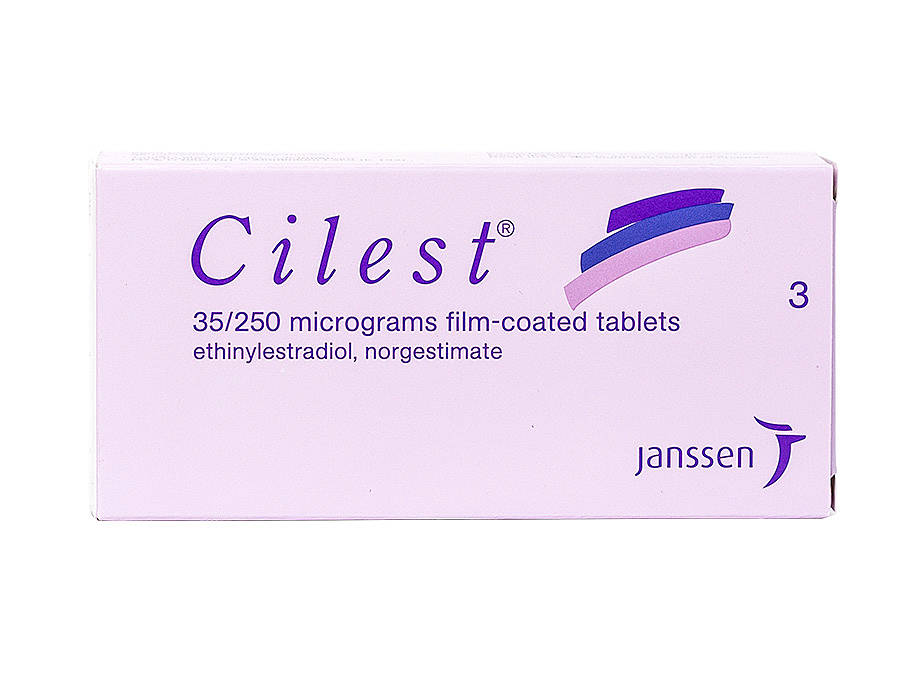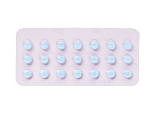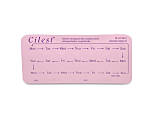Cilest
Order Consultation for the Contraceptive Pill






Please note – Cilest has been discontinued by the manufacturer. Please see our alternative contraceptive pills.
Cilest is a combined oral contraceptive. It contains the oestrogen Ethinylestradiol as well as the progesterone Norgestimate and has to be taken daily.
To place an order, fill in our brief questionnaire. You can choose a preferred treatment, such as Cilest. Our online doctor will review your information and approve an appropriate treatment. You can collect your medication from your nearest pharmacy or choose to get it delivered directly to your door.
A consultation for the contraceptive pill costs €21.50.



About Cilest
Important information: manufacturer discontinuation
Please note: in July 2019, the manufacturer of Cilest, Janssen, discontinued this medication.
If you’re currently using Cilest, you can switch to Cilique, which has the same active ingredients in the same dosage. ZAVA can help you make this switch easily by reordering online.
Because Cilest and Cilique contain the same composition of hormones, you won’t need to go through the normal pill-switching process, you can just reorder Cilique instead of Cilest and continue taking your pill as you normally do.
We do recommend that you finish your current pack of Cilest before you make the switch, just to make sure you take the right pills at the right time and there’s no gap in your contraceptive protection.
Who is Cilest for?
Cilest is a contraceptive pill for women under the age of 50, and prevents pregnancy. Like other combined pills, Cilest is a very reliable and safe type of contraceptive, which has to be taken daily in order to work effectively. It is suitable for most women, with the exception of those who are breastfeeding a baby less than 6 weeks old, have given birth recently, are allergic to any of the ingredients, have a history of cardiovascular disease, stroke or thrombosis, or have risk factors for these.
It’s not safe to prescribe a combined pill in women who are over 35 and smoke, are at risk of prolonged immobility, or who suffer with:
- obesity
- genetic conditions that increase blood clotting
- high blood pressure
- atrial fibrillation
- migraines with aura
- current or past breast cancer
- an increased risk of breast cancer
The combined pill may not be suitable in women who:
- have had organ transplants
- have gallbladder disease
- have liver problems
- have SLE
- have certain heart conditions
- have diabetes or high cholesterol
- have a family history of blood clots
Cilest is a prescription-only contraceptive and it’s very important that you discuss prior health problems with a doctor before choosing your a contraception. For a complete list of warnings, please read your patient leaflet.
It’s important that you inform your doctor of any previous illnesses or current or new conditions affecting your health. Other progesterone or non-hormonal contraception methods are available for women who can’t take a combined pill.
Is Cilest suitable for smokers? – smokers over the age of 35 are advised not to use contraceptives which contain oestrogen. This is due to the slight increase in the risk of blood clots, which is associated with the regular intake of oestrogen.
How does it prevent pregnancy?
In principle, all combined oral contraceptives work in a similar way – just like Cilest, they all prevent ovulation and lead to a thickening of the mucus around the entrance of the womb to prevent sperm from reaching an egg.
Does Cilest differ from other pills? – the main difference between the contraceptive pills currently on the market lies in the combination of hormones they contain. The active ingredients in Cilest are ethinylestradiol, an oestrogen which can be found in many other contraceptive pills, and the progesterone norgestimate. In combination, the two hormones provide a very reliable contraceptive effect.
How does sex work on Cilest? – while taking a contraceptive pill, you can enjoy spontaneous sex without having to worry about additional contraception. In this situation, it is easy to forget that with regards to sexually transmitted diseases, you are still having unprotected sex. It is vital that you continue to use a condom when having sex with partners whose health status you are unsure of. Having unprotected sex puts you at risk of contracting sexually transmitted infections such as gonorrhea, herpes, human papilloma virus and HIV.
How do I take Cilest?
When should I start taking it? – if you have recently been prescribed Cilest for the first time, you should begin your first course by taking the first tablet from the blister pack on days 1 to 5 of your period. This way, you will not require additional contraception. If you prefer to start taking Cilest on a later day in your cycle, you will need to use a barrier method such as a condom for 7 days, until contraception with Cilest is effective. Don’t take Cilest if you suspect you might already be pregnant, as it will have no contraceptive effect and may put you at increased risk.
What happens if I forget the pill? – if you have forgotten to take your pill but remember to take it within a 24-hour window, you are still protected. Just take your pill as soon as you remember and continue by taking the next pill at the usual time. This might mean taking two tablets on the same day. If you are more than 24 hours late, you may need to use an additional method of contraception for 7 days to ensure that you will not get pregnant. Whether this is necessary depends on when the missed pill occurred in your packet – please read the patient leaflet of your pill, which will give you detailed instructions on how to proceed in different scenarios. If a pill is taken more than 24 hours late and you have or have had unprotected sex, you may require emergency contraception depending on where this missed pill occurs in your pack and if you’ve missed any other pills. Please read your pill leaflet or discuss with a pharmacist, nurse, or doctor if you think you might need emergency contraception.
What if I want to stop taking Cilest? – if you would like to get pregnant and have decided to stop using contraception, you should finish your current blister pack of Cilest. After having taken your last tablet, you will no longer be protected from pregnancy. You will be able to get pregnant from the time of your next ovulation. Usually, this occurs within 1-2 weeks of taking your last contraceptive pill. In some cases however, it can take longer. Taking a contraceptive pill generally has no long-term impact on your fertility.
Cilest side effects and risks
Some women experience side effects when taking Cilest.
Very common (affecting 1 in 10 or more women) and common (affecting between 1 in 100 and 1 in 10 women) side effects include:
- Migraines. If these occur whilst taking Cilest, please stop the pill, use condoms, and see your doctor
- Headaches or dizziness
- Fluid retention
- Mood swings and depression
- Insomnia
- Abdominal pain, diarrhoea, vomiting, and nausea
- Constipation, bloating, and flatulence
- Skin conditions such as acne
- Muscle pain and spasms
- Painful breasts
- Vaginal discharge
- Chest pain. This should always be reviewed by a doctor to exclude other more serious causes
- Infections of the urinary tract and vagina such as cystitis and thrush
- Missing periods, heavier or more painful periods (if you miss a period always do a pregnancy test)
- Feeling tired or weak
There's a small increased risk of breast and cervical cancer and thrombosis (approximately 3 times the thrombosis risk of non pregnant women who aren’t taking contraception) with combined pills like Cilest.
Although weight gain is listed as a common side effect, there’s no clear link between the combined pill and weight gain.
You’ll find more information on rare side effects on the patient leaflet of your medication.
Drug Interactions - the following types of medicine can interact with the active ingredients of your pill and mean it may not be appropriate for you to take Cilest:
- Medication to treat epilepsy
- Certain types of medication used to treat high blood pressure in the blood vessels of the lung
- Some types of antibiotics
- Some anti-HIV medicines
- Some anti-hepatitis C medications
- Topiramate
- Griseofulvin
- Modafinil
- St. John’s Wort
- Some anti-sickness medication
- Charcoal
- Some types of medication used to treat high cholesterol levels
- Etoricoxib
- Ciclosporin
- Lamotrigine (the combined pill may make lamotrigine less effective)
- Prednisolone
- Theophylline
- Some laxatives and weight loss medications
- EllaOne, if taken within the last 5 days
Speak to your doctor or pharmacist if you’re unsure about any interaction or another medical condition. See the patient information leaflet provided with your contraceptive for a full list of interacting medicines and other medical conditions.
How long does Cilest take to work?
It depends on where you are in your monthly cycle when you first start taking it – if you have regular periods it’s best to take Cilest between days 1 – 5 of your period. Taking it during this time will ensure that you don’t need other contraceptive cover, as Cilest will be effective right away.
You can also start taking Cilest at any other time of your cycle, provided you are sure you are not pregnant. If you take Cilest after day 5 of your period or want to have sex in the meantime, you need other contraceptive cover, such as condoms for the first 7 days. You need to allow 7 days for Cilest to work effectively.
Vomiting and diarrhoea can reduce the effect of Cilest – if you vomit for any reason within 2 hours of taking Cilest, then take another pill as soon as possible. You won’t need extra contraceptive cover if taken within the 24-hour window. If vomiting or diarrhoea persist for more that 24 hours then you must:
- Follow the instructions for missed pills counting each day of vomiting and/or diarrhoea as a missed pill
- Avoid sex or use condoms during the time you are unwell and for 7 days afterwards
- If you are unwell during the last 7 days of taking your pill then start the next pill cycle without taking a 7-day break
Can I speed up its effect? – you won’t be able to speed up its effect, but taking it within days 1 – 5 of your period will ensure that Cilest is effective right away. When used correctly, Cilest can be more than 99% effective. Taking it correctly is the most important way to ensure that you have contraceptive cover.
As it can be tricky to remember to take this correctly, long-acting reversible contraceptives (LARC) such as the progesterone-only injection or implant and intrauterine device and intrauterine system, are more effective than the combined pill with typical day to day use.
Does Cilest help with acne?
Can Cilest get rid of acne? – like other combined hormonal contraceptives (CHC), it may help with acne symptoms. Once the hormones are balanced, the level of sebum on the skin reduces and your acne symptoms can improve. It may take a few months until you notice an improvement. Cilest can also help women who have symptoms of PMS and PCOS.
Is Cilest a good choice for acne treatment? – it may be suitable if you have hormonal acne and want contraception, otherwise other treatments may be better. Currently, Cilest is not licensed in the UK for use for acne alone. Another oral COC pill called co-cyprindiol is and can be prescribed for women with moderate to severe acne. One of its most common branded version is called, Dianette. This pill is known to have a higher risk of blood clots than most other combined pills, so it may not be appropriate for every woman. Speak to your doctor for further advice.
Please note – some contraceptives, such as the progestogen-only pill (mini-pill) or the contraceptive implant can make acne worse.
How often do I need to take Cilest?
In order to work effectively and provide safe contraception, Cilest has to be taken at the same time every day. The only exception is the 7 day pill break in the fourth week of your cycle. You’ll find 21 tablets in one Cilest blister pack. After three weeks of taking a tablet every day you will have one week without taking any tablets, during which you will experience a withdrawal bleed. You’re still protected during this week but it is important that you start the next blister pack after 7 days.
Sometimes it may be difficult to remember to start the next pack at the correct time and this can lead to a risk of pregnancy. Newer ways of taking combined pills like Cilest are commonly used and can reduce the risk of pregnancy and of experiencing any unwanted symptoms in the hormone-free week (although they’re perfectly safe, these regimes aren’t licensed by the manufacturer). One option is to have only a 4-day break before starting the next pack. Another is to take 3 packs (9 weeks) back to back, then have a 4-day or 7-day break before starting the next pack. Women can also take Cilest every day until bleeding occurs for 4 days in a row, then take a 4-day or 7-day break before starting the next pack, or continue to take Cilest every day with no breaks between packs when bleeding occurs.
Breakthrough bleeding is more common with the newer regimes. As each woman is individual you may wish to discuss with your pill prescriber which of these regimes would suit you best.
Active ingredient of Cilest
Cilest contains two active ingredients, ethinylestradiol and norgestimate. With every tablet, you are taking 250 micrograms norgestimate and 35 micrograms ethinylestradiol.
Very common side effects
- Headache
- Stomach problems including vomiting and diarrhoea
- Painful or heavy periods (Cilest can also be used to treat these symptoms in some women)

Dr Clair Grainger studied at The University of Edinburgh from 2004 to 2009. She's worked in hospitals throughout Edinburgh and London before completing her GP training in North Middlesex Hospital in 2017.
Meet our doctorsLast reviewed: 22 Feb 2019
